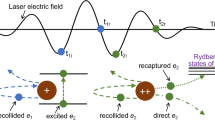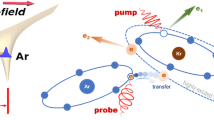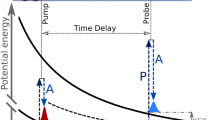Abstract
Double ionization following the absorption of a single photon is one of the most fundamental processes requiring interaction between electrons1,2,3. Information about this interaction is usually obtained by detecting emitted particles without access to real-time dynamics. Here, attosecond light pulses4,5, electron wave packet interferometry6 and coincidence techniques7 are combined to measure electron emission times in double ionization of xenon using single ionization as a clock, providing unique insight into the two-electron ejection mechanism. Access to many-particle dynamics in real time is of fundamental importance for understanding processes induced by electron correlation in atomic, molecular and more complex systems.
This is a preview of subscription content, access via your institution
Access options
Subscribe to this journal
Receive 12 print issues and online access
$259.00 per year
only $21.58 per issue
Buy this article
- Purchase on SpringerLink
- Instant access to full article PDF
Prices may be subject to local taxes which are calculated during checkout




Similar content being viewed by others
References
Briggs, J. S. & Schmidt, V. Differential cross sections for photo-double-ionization of the helium atom. J. Phys. B 33, R1–R48 (2000).
Avaldi, L. & Huetz, A. Photodouble ionization and the dynamics of electron pairs in the continuum. J. Phys. B 38, S861–S891 (2005).
Kheifets, A. S., Ivanov, I. A. & Bray, I. Timing analysis of two electron photoemission. J. Phys. B 44, 101003 (2011).
Paul, P. M. et al. Observation of a train of attosecond pulses from high harmonic generation. Science 292, 1689–1692 (2001).
Kienberger, R. et al. Atomic transient recorder. Nature 427, 817–821 (2004).
Klünder, K. et al. Probing single-photon ionization on the attosecond time scale. Phys. Rev. Lett. 106, 143002 (2011).
Eland, J. H. D. et al. Complete two-electron spectra in double photoionization: The rare gases Ar, Kr, and Xe. Phys. Rev. Lett. 90, 053003 (2003).
Schultze, M. et al. Delay in photoemission. Science 328, 1658–1662 (2010).
Goulielmakis, E. et al. Real-time observation of valence electron motion. Nature 466, 739–743 (2010).
Mauritsson, J. et al. Attosecond electron spectroscopy using a novel interferometric pump–probe technique. Phys. Rev. Lett. 105, 053001 (2010).
Schneider, T., Chocian, P. L. & Rost, J-M. Separation and identification of dominant mechanisms in double photoionization. Phys. Rev. Lett. 89, 073002 (2002).
Schmidt, V. Photoionization of atoms using synchrotron radiation. Rep. Prog. Phys. 55, 1483–1659 (1992).
Weber, T. et al. Correlated electron emission in multiphoton double ionization. Nature 405, 658–661 (2000).
Pfeiffer, A. N. et al. Timing the release in sequential double ionization. Nature Phys. 7, 428–433 (2011).
Kikas, A. et al. High-resolution study of the correlation satellites in photoelectron spectra of the rare gases. J. Electron Spectrosc. Relat. Phenom. 77, 241–266 (1996).
Alitalo, S. et al. The valence photoelectron satellite spectra of Kr and Xe. J. Electron Spectrosc. Relat. Phenom. 114–116, 141–146 (2001).
Laulan, S. & Bachau, H. Correlation effects in two-photon single and double ionization of helium. Phys. Rev. A 68, 013409 (2003).
Feist, J. et al. Probing electron correlation via attosecond XUV pulses in the two-photon double ionization of helium. Phys. Rev. Lett. 103, 063002 (2009).
De Morisson Faria, C. F. & Liu, X. Electron electron correlation in strong laser fields. J. Mod. Opt. 58, 1076–1131 (2011).
Horner, D. A., Morales, F., Rescigno, T. N., Martín, F. & McCurdy, C. W. Two-photon double ionization of helium above and below the threshold for sequential ionization. Phys. Rev. A 76, 030701 (2007).
Rantovic, P. et al. Laser-enabled Auger decay in rare-gas atoms. Phys. Rev. Lett. 106, 053002 (2011).
Guyétand, O. et al. Complete momentum analysis of multiphoton photo-double ionization of xenon by XUV and infrared photons. J. Phys. B 41, 065601 (2008).
Pazourek, R., Feist, J., Nagele, S. & Burgdörfer, J. Attosecond streaking of correlated two-electron transitions in helium. Phys. Rev. Lett. 108, 163001 (2012).
Guénot, D. et al. Photoemission-time-delay measurements and calculations close to the 3s-ionization-cross-section minimum in Ar. Phys. Rev. A 85, 053424 (2012).
Ivanov, M. & Smirnova, O. How accurate is the attosecond streak camera?. Phys. Rev. Lett. 107, 213605 (2011).
Dahlström, J. M., L’Huillier, A. & Maquet, A. Introduction to attosecond delays in photoionization. J. Phys. B 45, 183001 (2012).
Yip, F. L., Rescigno, T. N., McCurdy, C. W. & Martín, F. Fully differential single-photon double ionization of neon and argon. Phys. Rev. Lett. 110, 173001 (2013).
Amusia, M. Y. Atomic Photoeffect (Plenum Press, 1990).
Schnadt, J. et al. Experimental evidence for sub-3-fs charge transfer from an aromatic adsorbate to a semiconductor. Nature 418, 620–623 (2002).
Harbach, P. H. P., Schneider, M., Faraji, S. & Dreuw, A. Intermolecular coulombic decay in biology: The initial electron detachment from FADH− in DNA photolyases. J. Phys. Chem. Lett. 4, 943–949 (2013).
Acknowledgements
We thank A. Maquet and R. Taïeb for fruitful theoretical discussions. This research was supported by the Marie Curie program ATTOFEL (ITN), the European Research Council (ALMA), the Swedish Research Council and the Knut and Alice Wallenberg Foundation.
Author information
Authors and Affiliations
Contributions
E.P.M., D.G., C.L.A., D.K., S.K. and M.G. performed the experiment. E.P.M., J.M.D., E.L., A.S.K., D.G., A.L. and M.G. worked on the analysis and theoretical interpretation. E.P.M., S.L.S., A.L. and M.G. wrote the manuscript.
Corresponding author
Ethics declarations
Competing interests
The authors declare no competing financial interests.
Supplementary information
Supplementary Information
Supplementary Information (PDF 607 kb)
Rights and permissions
About this article
Cite this article
Månsson, E., Guénot, D., Arnold, C. et al. Double ionization probed on the attosecond timescale. Nature Phys 10, 207–211 (2014). https://doi.org/10.1038/nphys2880
Received:
Accepted:
Published:
Issue date:
DOI: https://doi.org/10.1038/nphys2880
This article is cited by
-
Attosecond electron–spin dynamics in Xe 4d photoionization
Nature Communications (2020)
-
Electronic wavefunctions probed by all-optical attosecond interferometry
Nature Photonics (2019)
-
Attosecond coupled electron and nuclear dynamics in dissociative ionization of H2
Nature Physics (2018)
-
Spectral phase measurement of a Fano resonance using tunable attosecond pulses
Nature Communications (2016)
-
Sub-10-fs control of dissociation pathways in the hydrogen molecular ion with a few-pulse attosecond pulse train
Nature Communications (2016)



